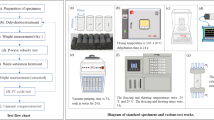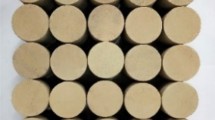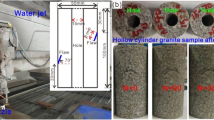Abstract
In order to further study the failure characteristics of freeze-thawed rocks in the alpine region under multistage cyclic loads, a numerical simulation analysis was carried out with RFPA2D software, taking the natural fractured granite from the Beizhan Iron Mine in Hejing County, Xinjiang Province as an example. The results show that the degree of natural fracture determines the fracture form of rock, and when the degree of natural fracture is large, the rock will eventually undergo shear slip failure along the natural fracture. When natural fissure rock is subjected to load, its initial structural deterioration occurs at the fissure, and tensile failure occurs. When the natural fracture expands to a certain extent, the rock begins to undergo large-scale compressive shear failure, which eventually leads to shear-slip failure of the fractured rock. The failure mode of fractured rock is affected by the degree of fracture development, the degree of penetration and the inclination Angle.
You have full access to this open access chapter, Download conference paper PDF
Similar content being viewed by others
Keywords
1 Introduction
With the deep implementation of the western development strategy, China has made greater efforts to develop mineral resources in the western high-altitude cold regions. In the process of mine construction, the problem of freezing and thawing disasters of the slopes in the cold regions has become increasingly prominent and has been paid attention to [1]. Among them, freeze–thaw cycle, mining, blasting, etc. are the main factors causing slope disasters in cold regions. It is of great significance to carry out research on the damage and failure process of freeze–thaw fissured rocks under multi-stage cyclic load for promoting the development of slope treatment in high cold regions in China, it is of great significance to prevent slope geological disaster and ensure mine safety production.
Many scholars have carried out number of studies on the physical and mechanical characteristics of rock and the law of crack growth under the action of freeze–thaw cycle, and obtained the results of reference value. Wen Lei et al. [2] studied the influence of freeze–thaw cycles at different temperature intervals on the mass loss rate, saturated water absorption rate, uniaxial compressive strength and other parameters of granite in water-saturated state. Zhang Huimei et al. [3] studied the influence of freezing and thawing cycles on red sandstone under different confining pressures. The results showed that with the freezing and thawing cycles, the mass and density of the sample increased first and then decreased, while the longitudinal wave velocity continued to decrease. Song Yongjun et al. [4] carried out uniaxial cyclic loading and unloading tests of red sandstone with different freeze–thaw cycles. The results showed that, with the increase of freeze–thaw cycles, the peak strength and elastic modulus of rock gradually decreased, while the peak strain and Poisson's ratio gradually increased, and the rock failure showed a trend of transition from brittleness to ductility. Zhou Shengtao et al. [5] studied the fracture morphology of sandstone under uniaxial compression with different times of freeze–thaw cycles. Liu Quansheng et al. [6] pointed out that the dynamic frost heaving force in fractured rock mass was related to the physical parameters, strength parameters, freezing temperature and fracture morphology of the rock mass through the laboratory freeze–thaw test and the establishment of a theoretical model, and the frost heaving force value was considered under the condition of water migration and non-migration. By preforming fractures in red sandstone, Renliang et al. [7] analyzed the evolution law of frost heaving force in penetrating fractures, and verified the damage and deterioration effect of frost heaving force on fractured rock mass. Li Ping et al. [8] prepared sandstone-like samples with similar materials and prefabricated double cracks with different rock bridge angles. Through a series of laboratory tests, they obtained the propagation characteristics of rock cracks caused by frost heaving. Zhao Jianjun et al. [9] studied the effects of fractures of different lengths on freeze–thaw damage deterioration of rocks using rock-like materials, and the results showed that freeze–thaw cycling had significant effects on pore fracture compaction stage and main fracture expansion stage in rock uniaxial compression test.
At present, scholars focus on the failure of freeze–thaw cyclic rock under monotonic loading, and rarely study the failure mechanism of freeze–thaw fractured rock under multistage cyclic loading. Therefore, based on the engineering background of Beizhan Iron Mine in Hejing County, Xinjiang, using the rock dynamic fracture analysis system RFPA2D, this paper aims to study the characteristics of the activation process and fracture morphology of the structural planes of natural fracture samples after freezing and thawing.
2 Model and Test Scheme
2.1 Model Establishment
The model test of this paper, natural fissure granites from the Beizhan Iron mine in Hejing County, Xinjiang Province were selected, which are mainly distributed in the west slope of the open-pit mine, and the representative rock mass structural plane inclination is 290° and inclination is 70°. Further select typical crack samples NFG-19, NFG-22, NFG-33 and NFG-35 for numerical analysis, and the sample model size is 50 × 100 mm, the natural fissure volume ratio Rv of each sample is 0.12, 0.08, 2.11 and 0.56% respectively, as shown in Fig. 1.
The corresponding analysis model is built through the rock dynamic fracture analysis system RFPA2D. The model is divided into two parts: sample and cushion block. The parameters of the two materials are shown in Table 1. Mohr Coulomb model is selected as the constitutive model, The expression is:
In the formula, \({{\varvec{\sigma}}}_{1}\) and \({{\varvec{\sigma}}}_{3}\) stand for maximum and minimum principal stresses, \({\varvec{c}}\) and \(\boldsymbol{\varphi }\) stand for cohesion and internal friction angle.
2.2 Simulation Scheme
Combined with the engineering practice, the test was carried out by multistage cyclic loading, loading mode and loading path of the model, as shown in Fig. 2.
During the simulation, the mechanical simulation test of cyclic loading and unloading was carried out on the model specimen with a stress increase of 3 MPa. The stress loading time step was 1 × e−5 s. The plane stress model was used in the calculation and simulation, and the total loading step was set as 160 steps. In the first loading stage, the sample model is loaded and unloaded for 5 cycles. In each subsequent stage, the average stress increases by 3 MPa, and the sample model is loaded again for 5 cycles. In this way, the multi-stage cyclic loading is continued until the instability calculation of all models is stopped, and the stress map and acoustic emission map in the simulation process are compared and analyzed.
3 Analysis of Numerical Calculation Results
As the loading time goes on, the gradual fracture process of the sample model can be clearly observed through the rock dynamic fracture analysis system RFPA2D software during the loading process. The representative stress field diagram and acoustic emission dynamic distribution diagram of each loading stage in the sample model are selected for analysis. Limited to space, only the test results of NFG-19 and NFG-33 are displayed.
3.1 Analysis of NFG-1 Simulation Results
The NFG-19 specimen was subjected to graded loading with a 3 MPa stress increase cycle until the specimen was damaged, and the fracture damage process is shown in Fig. 3.
As shown Fig. 3(a), it can be seen that at the beginning of loading, it is obvious that stress concentration occurs at the fissures of the specimen model, and with the increase of loading steps, the specimen model firstly changes at the ends of the fissures, and the fissures may expand or new pores or micro fissures may sprout by the load excitation, and finally, with the continuous expansion of the fissures in the model leading to the destabilization of the specimen model, the upper part of the model shows signs of slippage along the fissures, and a slight rupture of the rock matrix at the lower part of the model can be found.
As shown Fig. 3(b), it can be seen that the model was firstly damaged at the pre-existing fracture, and the damage point was close to the model surface, with the loading step, the specimen model underwent deeper rupture, but the damage point was always at the pre-existing fracture. There are red and white circles with different diameters in the dynamic distribution of acoustic emission, and the diameter of the circles in the Figure represents the relative size of acoustic emission intensity. With the expansion scale of the original natural fracture increasing, the model undergoes large-scale shear slip along the natural fracture, and the acoustic emission phenomenon of compression-shear damage gradually increases, so the final damage of the model is in the form of shear slip along the original fracture.
3.2 Analysis of NFG-33 Simulation Results
The NFG-33 specimen was subjected to graded loading with a 3 MPa stress increase cycle until the specimen was damaged, and the fracture damage process is shown in Fig. 4.
Comparing Fig. 3(a) and Fig. 4(a), the NFG-33 model has a strong similarity with NFG-19 in terms of overall morphology during the loading process, both of which are the gradual expansion of the pre-existing fracture by the load, which eventually leads to the shear slip damage of the specimen model, but the NFG-33 model loading step occurs near the ring-breaking stage when the expansion occurs at the fracture tip and the new fracture sprouts inside the specimen model.
As shown Fig. 4(b), the NFG-33 specimen model also produces tensile damage at the beginning of loading, which leads to the expansion of pre-existing fractures, and as the loading step proceeds, the degree of fracture expansion gradually increases and compression-shear damage of different sizes occurs, similar the NFG-19 specimen model, and the final damage of the model is in the form of shear slip along the original fractures.
Due to the large initial extension and better penetration of the fracture in specimen NFG-33, the final acoustic emission distribution of the loading step shows that specimen NFG-19 also ruptures at the non-fracture, while specimen NFG-33 only extends at the tip of the fracture. When the structural face of the rock is developed to a certain extent, it gradually controls the strength of the whole rock, which makes the rock more prone to shear damage along the structural face during rupture, and in Fig. 4(b), the number of white circles is significantly more, i.e., more compression-shear damage occurred.
Figure 5 shows the actual damage pattern of the freeze–thaw granite sample containing natural fissures under multi-stage cyclic loading, the test results show that the specimen produced new fissures during the cyclic loading process, and the final destabilization damage occurred in the form of shear slip damage along the original natural fissures, which verifies the reasonableness of the numerical simulation.
4 Conclusion
In this study, using the rock dynamic rupture analysis software RFPA2D, the structural surface characteristics of representative granite rocks from Beizhan Iron Mine were selected for modeling and numerical simulations were performed using a multi-cycle loading path written by ourselves, and the structural surface activation process characteristics and rupture morphology of natural fracture specimens after freeze–thaw were studied in a targeted manner, and the main conclusions reached were as follows:
-
(1)
The development degree of natural fissures determines the rupture form of the rock, when the development degree of natural fissures is large, the rock will eventually shear slip damage along the natural fissures, the less developed fissured rocks, the damage form is close to the intact rock.
-
(2)
When the natural fractured rocks are subjected to loading, the initial structural deterioration occurs at the fractures, and tensile damage often occurs, making the natural fractures continue to expand, and when the natural fractures expand to a certain degree, the rocks begin to undergo large-scale compression-shear damage, which eventually leads to shear-slip damage of the fractured rocks.
-
(3)
The damage form of fractured rocks is not only related to the development degree of fractures inside the rocks, but also related to the penetration degree and tilt angle of fractures.
References
Li C, Xiao Y, Wang Y (2019) Research status and trend of deformation and failure mechanism of rock slope in cold area of High altitude. J Eng Sci 41(11):1374–1386
Wen L, Li X (2017) Study on physical and mechanical properties of rock subjected to freeze-thaw in variable temperature range and its application in engineering. Chin J Eng Mech 34(5):247–256
Zhang H, Xia H, Yang G (2018) Experimental study on effects of freeze-thaw cycle and confining pressure on physical and mechanical properties of rock. J China Coal Soc 43(2):441–448
Song Y, Zhang L, Ren J (2019) Experimental study on Mechanical properties of red sandstone under cyclic loading after freeze-thawing. Coal Eng 51(2):112–117
Zhou S, Fang W, Jiang N (2020) Fractal study on fracture characteristics of sandstone under uniaxial compression under freeze-thaw cycle. Bull Geol Sci Technol 39(5):61–68
Liu Q, Huang S, Kang Y (2015) Research progress and consideration on freeze-thaw damage of fractured rock mass. Chin J Rock Mech Eng 34(3):452–471
Shan R, Bai Y, Sun P (2019) Experimental study on frost heaving force of fractured red sandstone. J China Coal Soc 44(6):1742–1752
Li P, Tang X, Liu Q (2020) Study on frost heaving fracture characteristics and strength loss of sandstone with double fractures. Chin J Rock Mech Eng 39(1):115–125
Zhao J, Xie M, Yu J (2019) Experimental study on mechanical characteristics and damage evolution law of fractured rock under freeze-thaw. J Eng Geol 27(6):1199–1207
Acknowledgements
The authors would like to thank the editors and the anonymous reviewers for their help fand constructive comments.
Author information
Authors and Affiliations
Corresponding author
Editor information
Editors and Affiliations
Rights and permissions
Open Access This chapter is licensed under the terms of the Creative Commons Attribution 4.0 International License (http://creativecommons.org/licenses/by/4.0/), which permits use, sharing, adaptation, distribution and reproduction in any medium or format, as long as you give appropriate credit to the original author(s) and the source, provide a link to the Creative Commons license and indicate if changes were made.
The images or other third party material in this chapter are included in the chapter's Creative Commons license, unless indicated otherwise in a credit line to the material. If material is not included in the chapter's Creative Commons license and your intended use is not permitted by statutory regulation or exceeds the permitted use, you will need to obtain permission directly from the copyright holder.
Copyright information
© 2023 The Author(s)
About this paper
Cite this paper
Peng, L. (2023). Study on Failure Process of Freeze–Thaw Fractured Rock Under Multistage Cyclic Loads. In: Feng, G. (eds) Proceedings of the 9th International Conference on Civil Engineering. ICCE 2022. Lecture Notes in Civil Engineering, vol 327. Springer, Singapore. https://doi.org/10.1007/978-981-99-2532-2_12
Download citation
DOI: https://doi.org/10.1007/978-981-99-2532-2_12
Published:
Publisher Name: Springer, Singapore
Print ISBN: 978-981-99-2531-5
Online ISBN: 978-981-99-2532-2
eBook Packages: EngineeringEngineering (R0)









